
Myrmeciinae is a subfamily of the Formicidae, ants once found worldwide but now restricted to Australia and New Caledonia. This subfamily is one of several ant subfamilies which possess gamergates, female worker ants which are able to mate and reproduce, thus sustaining the colony after the loss of the queen. The Myrmeciinae subfamily was formerly composed of only one genus, Myrmecia, but the subfamily was redescribed by Ward & Brady in 2003 to include two tribes and four genera: An additional three genera, one form genus, and 9 species were described in 2006 from the Early Eocene of Denmark, Canada, and Washington.

Nothomyrmecia, also known as the dinosaur ant or dawn ant, is a rare genus of ants consisting of a single species, Nothomyrmecia macrops. These ants live in South Australia, nesting in old-growth mallee woodland and Eucalyptus woodland. The full distribution of Nothomyrmecia has never been assessed, and it is unknown how widespread the species truly is; its potential range may be wider if it does favour old-growth mallee woodland. Possible threats to its survival include habitat destruction and climate change. Nothomyrmecia is most active when it is cold because workers encounter fewer competitors and predators such as Camponotus and Iridomyrmex, and it also increases hunting success. Thus, the increase of temperature may prevent them from foraging and very few areas would be suitable for the ant to live in. As a result, the IUCN lists the ant as Critically Endangered.

Sphecomyrma is an extinct genus of ants which existed in the Cretaceous approximately 79 to 92 million years ago. The first specimens were collected in 1966, found embedded in amber which had been exposed in the cliffs of Cliffwood, New Jersey, by Edmund Frey and his wife. In 1967, zoologists E. O. Wilson, Frank Carpenter and William L. Brown, Jr. published a paper describing and naming Sphecomyrma freyi. They described an ant with a mosaic of features—a mix of characteristics from modern ants and aculeate wasps. It possessed a metapleural gland, a feature unique to ants. Furthermore, it was wingless and had a petiole which was ant-like in form. The mandibles were short and wasp-like with only two teeth, the gaster was constricted, and the middle and hind legs had double tibial spurs. The antennae were, in form, midway between the wasps and ants, having a short first segment but a long flexible funiculus. Two additional species, S. canadensis and S. mesaki, were described in 1985 and 2005, respectively.

Prionomyrmex is an extinct genus of bulldog ants in the subfamily Myrmeciinae of the family Formicidae. It was first described by Gustav Mayr in 1868, after he collected a holotype worker of P. longiceps in Baltic amber. Three species are currently described, characterised by their long mandibles, slender bodies and large size. These ants are known from the Eocene and Late Oligocene, with fossil specimens only found around Europe. It is suggested that these ants preferred to live in jungles, with one species assumed to be an arboreal nesting species. These ants had a powerful stinger that was used to subdue prey. In 2000, it was suggested by Cesare Baroni Urbani that the living species Nothomyrmecia macrops and a species he described both belonged to Prionomyrmex, but this proposal has not been widely accepted by the entomological community. Instead, scientists still classify the two genera distinctive from each other, making Nothomyrmecia a valid genus.
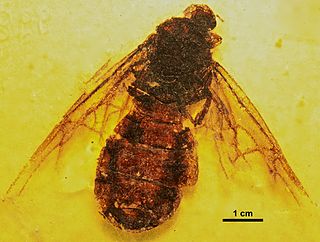
Titanomyrma is a genus of prehistoric giant ant. The latest species to be discovered, T. lubei, was described in 2011, when a 49.5-million-year-old fossilized winged queen ant, comparable in size to hummingbirds, was found in Wyoming, United States. This fossil is the first fossil of a giant ant found in the Western Hemisphere. The presence of Titanomyrma in North America is considered to indicate "the first reported cross-Arctic dispersal by a thermophilic insect group". Another fossil species of this genus, T. gigantea, is the largest-known fossil or extant species of giant ant in the world.

Ypresiomyrma is an extinct genus of ants in the subfamily Myrmeciinae that was described in 2006. There are four species described; one species is from the Isle of Fur in Denmark, two are from the McAbee Fossil Beds in British Columbia, Canada, and the fourth from the Bol’shaya Svetlovodnaya fossil site in Russia. The queens of this genus are large, the mandibles are elongated and the eyes are well developed; a stinger is also present. The behaviour of these ants would have been similar to that of extant Myrmeciinae ants, such as solitary foraging for arthropod prey and never leaving pheromone trails. The alates were poor flyers due to their size, and birds and animals most likely preyed on these ants. Ypresiomyrma is not assigned to any tribe, and is instead generally regarded as incertae sedis within Myrmeciinae. However, some authors believe Ypresiomyrma should be assigned as incertae sedis within Formicidae.
Avitomyrmex is an extinct genus of bulldog ants in the subfamily Myrmeciinae which contains three described species. The genus was described in 2006 from Ypresian stage deposits of British Columbia, Canada. Almost all the specimens collected are queens, with an exception of a single fossilised worker. These ants are large, and the eyes are also large and well developed; a sting is present in one species. The behaviour of these ants may have been similar to extant Myrmeciinae ants, such as foraging solitarily for arthropod prey and never leaving pheromone trails to food sources. Avitomyrmex has not been assigned to any tribe, instead generally being regarded as incertae sedis within Myrmeciinae. However, its identity as an ant has been challenged, although it is undoubtedly a hymenopteran insect.

Macabeemyrma is an extinct genus of bulldog ants in the subfamily Myrmeciinae containing the single species Macabeemyrma ovata, described in 2006 from Ypresian stage deposits of British Columbia, Canada. Only a single specimen is known; a holotype queen found preserved as a compression fossil. The specimen had no wings and small portions of its legs and eyes were faintly preserved. It was a large ant, reaching 25 millimetres (0.98 in) in length. This ants' behaviour would have been similar to that of extant Myrmeciinae ants, such as foraging singly in search for arthropod prey and nesting in soil or in trees. Macabeemyrma shows similarities to extinct ants in the genus Ypresiomyrma, and to the living Nothomyrmecia macrops, but has not been conclusively assigned to any tribe, instead generally regarded as incertae sedis within Myrmeciinae. However, the sole specimen lacks definitive traits, and its classification in Myrmeciinae, and even its identity as an ant, has been challenged.
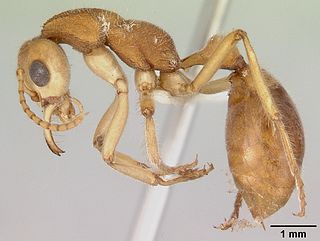
Prionomyrmecini is an ant tribe belonging to the subfamily Myrmeciinae established by William Morton Wheeler in 1915. Two members are a part of this tribe, the extant Nothomyrmecia and the extinct Prionomyrmex. The tribe was once considered a subfamily due to the similarities between Nothomyrmecia and Prionomyrmex, but such reclassification was not widely accepted by the scientific community. These ants can be identified by their long slender bodies, powerful stingers and elongated mandibles. Fossil Prionomyrmecini ants were once found throughout Europe, possibly nesting in trees and preferring jungle habitats. Today, Prionomyrmecini is only found in Australia, preferring old-growth mallee woodland surrounded by Eucalyptus trees. Nothomyrmecia workers feed on nectar and arthropods, using their compound eyes for prey and navigational purposes. Owing to their primitive nature, they do not recruit others to food sources or create pheromone trails. Nothomyrmecia colonies are small, consisting of 50 to 100 individuals.

Sphecomyrminae is an extinct subfamily of ants in family Formicidae known from a series of Cretaceous fossils found in North America, Europe, and Asia. Sphecomyrminae contains eight genera, divided into two tribes Sphecomyrmini and Zigrasimeciini. The tribe Sphecomyrmini contains the six genera Armania, Cretomyrma, Gerontoformica, Orapia, Pseudarmania and Sphecomyrma; while Zigrasimeciini contains Boltonimecia and Zigrasimecia. A number of taxa have been removed from the subfamily and placed either in other subfamilies or are now treated as incertae sedis in Formicidae.

Tatuidris, or armadillo ant, is a rare genus of ants consisting of a single species, Tatuidris tatusia. The ants are small in size and inhabit the leaf litter of Neotropical forests in Central and South America, from Mexico to Brazil. Workers are ferruginous-colored to dark red and present a distinctive morphology, consisting of a shield-like head with a broad vertex, ventrally-turned heavy mandibles which do not overlap at full closure, and unique among ants – an antenna socket apparatus sitting upside-down. Little is known about the biology of the ants, but they are likely nocturnal and specialist predators.

Brownimecia is an extinct genus of ants, the only genus in the tribe Brownimeciini and subfamily Brownimeciinae of the Formicidae. Fossils of the single identified species, Brownimecia clavata, are known from the Middle Cretaceous of North America. The genus is one of several ants described from Middle Cretaceous ambers of New Jersey. Brownimecia was initially placed in the subfamily Ponerinae, until it was transferred to its own subfamily in 2003; it can be distinguished from other ants due to its unusual sickle-like mandibles and other morphological features that makes this ant unique among the Formicidae. The ant is also small, measuring 3.43 millimetres (0.135 in), and a stinger is present in almost all of the specimens collected. The morphology of the mandibles suggest a high level of feeding specialization.

Burmomyrma is an extinct genus of ant-mimic wasp in the extinct family Falsiformicidae. The genus contains a single described species, Burmomyrma rossi. Burmomyrma is known from a single Middle Cretaceous fossil which was found in Asia.
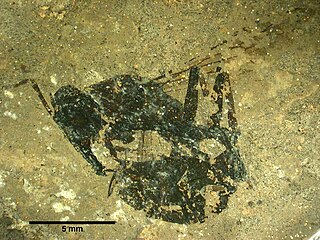
Archimyrmex is an extinct genus of ant in the formicid subfamily Myrmeciinae, described by palaeoentomologist Theodore Cockerell in 1923. The genus contains four described species, Archimyrmex rostratus, Archimyrmex piatnitzkyi, Archimyrmex smekali and Archimyrmex wedmannae. Archimyrmex is known from a group of Middle Eocene fossils which were found in North America, South America, and Europe. The genus was initially placed in the subfamily Ponerinae, but it was later placed in Myrmeciinae; it is now believed to be the ancestor of the extant primitive genus Myrmecia from Australia. Despite this, Archimyrmex is not a member to any tribe and is regarded as incertae sedis within Myrmeciinae. However, some authors believe Archimyrmex should be assigned as incertae sedis within Formicidae. These ants can be characterised by their large mandibles and body length, ranging from 13.2 to 30 mm. They also have long, thin legs and an elongated mesosoma (thorax) and petiole.
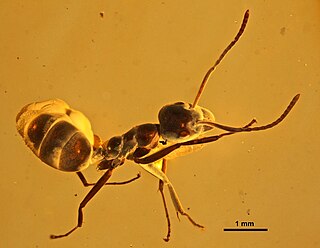
Yantaromyrmex is an extinct genus of ants first described in 2013. Members of this genus are in the subfamily Dolichoderinae of the family Formicidae, known from Middle Eocene to Early Oligocene fossils found in Europe. The genus currently contains five described species, Y. constrictus, Y. geinitzi, Y. intermedius, Y. mayrianum and Y. samlandicus. The first specimens were collected in 1868 and studied by Austrian entomologist Gustav Mayr, who originally placed the fossils in other ant genera until the fossils were reviewed and subsequently placed into their own genus. These ants are small, measuring from 4 to 6 mm in length and can be characterized by their trapezoidal shaped head-capsules and oval compound eyes that are located slightly to the rear of the capsules midpoint, with no known ocelli present.
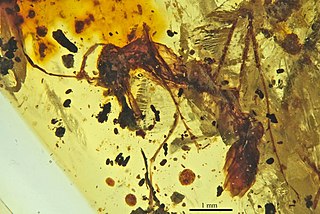
Myanmyrma is an extinct genus of ants not placed into any Formicidae subfamily. Fossils of the single known species, Myanmyrma gracilis, are known from the Middle Cretaceous of Asia. The genus is one of several ants described from Middle Cretaceous ambers of Myanmar.

Camelomecia is an extinct genus of stem-group ants not placed into any Formicidae subfamily. Fossils of the single known species, Camelomecia janovitzi, are known from the Middle Cretaceous of Asia. The genus is one of several ants described from Middle Cretaceous ambers of Myanmar.
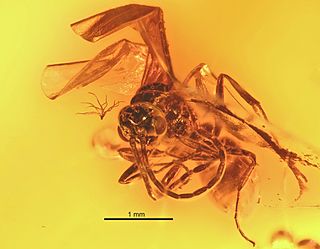
Pachycondyla succinea is an extinct species of ant in the formicid subfamily Ponerinae described from fossils found in Europe. P. petrosa is one of three middle Eocene Pachycondyla species found in Baltic amber.
Klondikia is an extinct hymenopteran genus in the ant family Formicidae with a single described species Klondikia whiteae. The species is solely known from the Early Eocene sediments exposed in northeast Washington state, United States. The genus is currently not placed into any ant subfamily, being treated as incertae sedis.

















